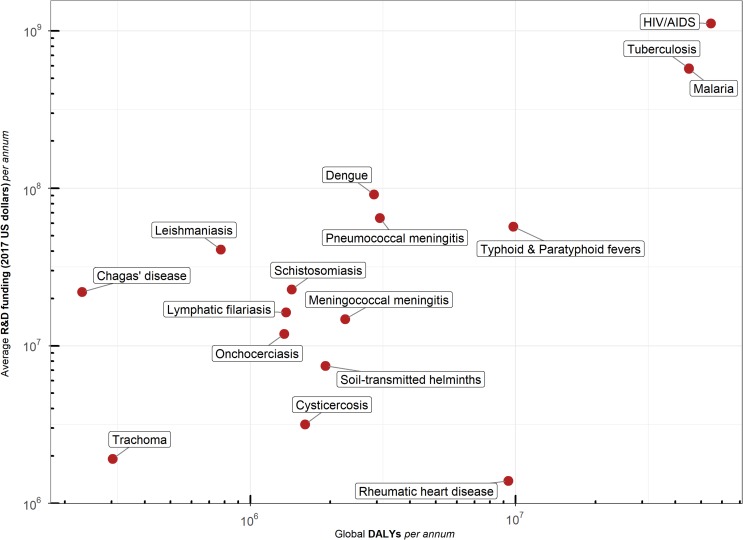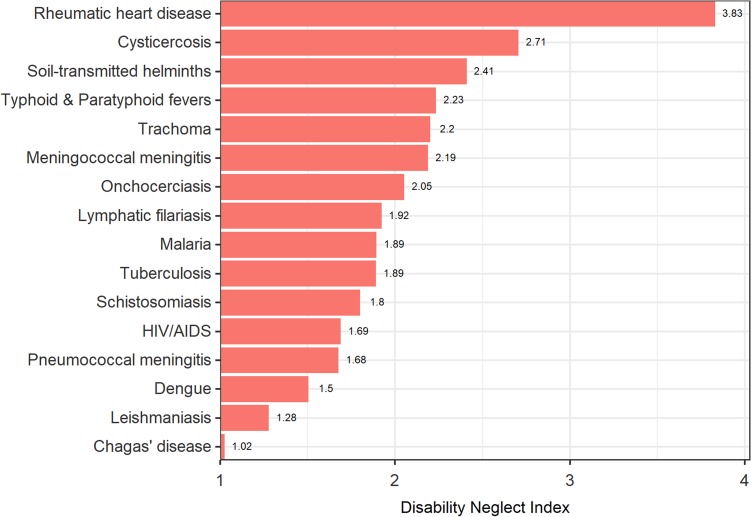Abstract
Background
Despite the substantial global burden of disease, rheumatic heart disease research receives little funding globally.
Methods
Using data from the Global Burden of Disease Study and funding from the G-FINDER database, we propose a novel logarithmic disability neglect index (DNI) to describe disease burden using disability-adjusted life years relative to funding for 16 major tropical diseases.
Results
Across a range of diseases, rheumatic heart disease received the least funding relative to disease burden (DNI=3.83). Other diseases facing similar underfunding include cysticercosis (DNI=2.71) and soil-transmitted helminths (DNI=2.41).
Conclusions
Rheumatic heart disease remains severely underfunded relative to disease burden.
Keywords: burden, DALYs, funding, neglect, rheumatic heart disease
Background
Rheumatic heart disease (RHD) is a long-term consequence of an aberrant immune response to the bacterium Streptococcus pyogenes (Group A streptococcus [GAS]) that leads to scarring and dysfunction of the heart valves.1 The disease is thought to develop years after the onset of an acute immunological response to GAS pharyngitis, or GAS impetigo in the tropics.2 RHD most commonly presents in adolescence or early adulthood with palpitations and shortness of breath. In addition to being a major cause of heart failure and stroke, RHD is highly likely to be the leading cause of cardiac death in children and young adults in developing countries.3,4
RHD is thought to affect at least 33 million people globally, causing an estimated 300 000 deaths each year,5 yet a poor understanding of disease pathogenesis has limited the opportunities for innovations in disease control.6 Despite the huge burden of disability, RHD continues to receive relatively little attention from researchers and the global health community alike, and attracts little research funding relative to its global burden, totalling approximately US$1.2 million in research funding in 2017.7 Indeed, it is often said that relative to its global burden, RHD receives limited research funding, but the degree to which it is underfunded has not previously been quantified. We therefore set out to explore the extent to which the burden of a tropical disease relates to the quantity of research funding the disease attracts. We compared disease-specific funding and disability-adjusted life years (DALYs) for a range of infectious diseases of global significance. Here we propose a simple and objective method for comparing relative funding neglect between diseases to identify diseases such as RHD that suffer from severe underfunding relative to their overall global burden.
Methods
Using data from the Global Burden of Disease, Injuries, and Risk Factors Study 2017,7 we obtained disease-specific burden estimated by DALYs, with analysis restricted to infectious diseases with >100 000 attributable DALYs per year.
Disease-specific research and development funding was obtained from the freely available G-FINDER public search tool.8 Five-year average funding estimates over the period 2013–2017 were used to limit bias in cases where significant grants had been made in a given year, with all estimates adjusted for inflation to 2017 US dollars. Only disease-specific funding was considered, so it is possible that the true total disease funding attributed to some diseases is higher than reported since individual grants may cover a range of diseases in some instances.
We explored variations of funding mapped to disease burden using visual plots and created a logarithmic disability neglect index (DNI), defined as the negative common logarithm (i.e. −log10) of DALYs (in thousands) divided by funding in US dollars (in millions) for each disease, to compare the extent to which disease funding varies by the associated global disability burden.
Results
We identified paired funding and disability and/or mortality data for 16 tropical infectious diseases for which data were available (Table 1, Figure 1). The total funding attributed to these diseases from 2013 to 2017 was US$13.1 billion (mean US$2.6 billion per year). These diseases contributed >180 million DALYs and 3.3 million deaths in 2017. Human immunodeficiency virus (HIV)/acquired immune deficiency syndrome (AIDS), tuberculosis (TB) and malaria were associated with 2.7 million deaths and 144 million DALYs in 2017. After these, the next two largest contributions to mortality and disability were RHD (285 000 deaths, 9.4 million DALYs) and typhoid/paratyphoid fever (136 000 deaths, 9.8 million DALYs).
Table 1.
Research and development (R&D) funding and associated DALYs in 2017 for RHD and 15 major tropical infectious diseases (Global Burden of Disease Study 2017, G-FINDER public research tool 2017) with associated DNI
| Diseasea | Yearly R&D spending (million US$)b | DALYsd (1000s) | R&D (US$ per DALY) | DNIe | |||||
|---|---|---|---|---|---|---|---|---|---|
| 2013 | 2014 | 2015 | 2016 | 2017 | 5-y averagec | ||||
| RHD | 0.9 | 1.3 | 2.3 | 1.3 | 1.2 | 1.39 | 9393 | 0.15 | 3.83 |
| Cysticercosis | 1.79 | 2.39 | 2.69 | 3.61 | 5.37 | 3.17 | 1608 | 1.97 | 2.71 |
| Soil-transmitted helminths | 8 | 7.7 | 8.3 | 7 | 6.3 | 7.47 | 1919 | 3.89 | 2.41 |
| Typhoid and paratyphoid fever | 47.8 | 47.9 | 55 | 71.4 | 63.7 | 57.17 | 9801 | 5.83 | 2.23 |
| Trachoma | 2.2 | 1.35 | 1.15 | 2.18 | 2.67 | 1.91 | 302.9 | 6.31 | 2.2 |
| Meningococcal meningitis | 18.9 | 12.23 | 7.44 | 24.57 | 10.67 | 14.76 | 2279 | 6.48 | 2.19 |
| Onchocerciasis | 14.8 | 9.7 | 12.7 | 10.2 | 12 | 11.89 | 1343 | 8.85 | 2.05 |
| Lymphatic filariasis | 15.38 | 21.36 | 13.71 | 15.82 | 15.21 | 16.29 | 1364 | 11.94 | 1.92 |
| Malaria | 532.6 | 578.1 | 564.5 | 576.8 | 624 | 575.18 | 45 015 | 12.78 | 1.89 |
| TB | 564.4 | 569.4 | 577.9 | 570.4 | 615.4 | 579.48 | 44 997 | 12.88 | 1.89 |
| Schistosomiasis | 24.51 | 26.4 | 20.36 | 18.37 | 24.24 | 22.77 | 1431 | 15.91 | 1.8 |
| HIV/AIDS | 1119.99 | 1080.93 | 1030.85 | 1102.3 | 1256.76 | 1116.16 | 54 446 | 20.5 | 1.69 |
| Pneumococcal meningitis | 69.2 | 51.38 | 73.67 | 66.1 | 63.35 | 64.74 | 3077 | 21.04 | 1.68 |
| Dengue | 76 | 85.86 | 101.13 | 112.8 | 81.33 | 91.44 | 2923 | 31.28 | 1.5 |
| Leishmaniasis | 34.27 | 44.67 | 40.12 | 41.25 | 44.15 | 40.89 | 774 | 52.83 | 1.28 |
| Chagas disease | 27.2 | 21.37 | 19.11 | 24.55 | 17.73 | 21.99 | 232 | 94.78 | 1.02 |
| Total | 2558 | 2562 | 2531 | 2649 | 2844 | 2627 | 180 905 | – | – |
aAll diseases for which paired disease-specific data were available from G-FINDER and the Global Burden of Disease Study 2017.
bTotal grants to disease projects in 2017 (G-FINDER).
cMean of funding years 2013–2017, adjusted for inflation to 2017 US dollars.
dDALYs (Global Burden of Disease Study 2017).
eCalculated as the negative common logarithm of (DALYs [in thousands]/Funding [in US$ millions]).
Figure 1.
Research and development (R&D) funding (US$) and associated DALYs for RHD as well as 15 major tropical infectious diseases (Global Burden of Disease Study 2017, G-FINDER public research tool 2017). Data presented on a logarithmic scale.
Figure 2 shows the DNI for all included diseases. The mean of all estimates was 2.01 (US$9.77 per DALY) and the mean for HIV/AIDS, TB and malaria combined was 1.82 (US$15.02 per DALY). The highest values (lowest number of US$s per DALY) were RHD (3.83 [US$0.15 per DALY]), cysticercosis (2.71 [US$1.84 per DALY]) and soil-transmitted helminths (2.41 [US$3.89 per DALY]).
Figure 2.
Logarithmic DNI (estimated as the negative common logarithm [−log10]) of DALYs (in thousands) divided by funding (in US$ millions) for each disease.
Discussion
Despite growing recognition that RHD is a global public health concern,5,9 much remains to be done and substantial financial investment is needed, particularly to develop and trial a safe vaccine against the causative GAS. It therefore remains necessary to demonstrate to funders that the global burden of this disease outstrips research and development spending. Consequently we have attempted to quantify that discrepancy and make objective comparisons with other important infectious diseases of global concern.
The DNI is higher for RHD than any other disease we assessed and is 2 points higher than HIV/AIDS, TB and malaria. To put this in context, on average, each dollar of RHD research funding has to contend with 100 times the number of DALYs of a dollar given to each of HIV/AIDs, TB and malaria. However, our analysis is dependent on the funding and disease burden estimates underlying the index. While these are the best available, disease burden estimates for neglected diseases including RHD are notoriously limited.10 It is likely that for RHD, both global death and disability estimates are conservative.5 Similarly, estimates of funding may be inaccurate, not least because some smaller sources of funding may not be included in the G-FINDER tool. Moreover, some funding may not necessarily be allocated to a given disease, despite substantial future potential impact. For example, funding for the development of a GAS vaccine or work on the pathogenesis of GAS disease may have important implications for RHD without the funding having been targeted at RHD itself.
All diseases in this list are underfunded, especially cysticercosis, soil-transmitted helminths and typhoid/paratyphoid fever, but the huge differences seen here between RHD and other important tropical infectious diseases is striking. We propose our index will help make the case for further investment in RHD research as well as become a useful tool across a variety of tropical infectious diseases that are almost universally underfunded.
Authors’ contributions
CKM and TP conceived the study, carried out the data collection and presentation and drafted the manuscript. CKM, TP, AS, JK, PB and DM carried out interpretation of the data. AS, PB, JK and DM critically revised the manuscript for intellectual content. All authors read and approved the final manuscript. CKM and TP are guarantors of the paper.
Acknowledgements
None.
Funding
TP received funding from the National Institute for Health Research, UK (grant ACF-2016-20-001).
Competing interests
None declared.
Ethical approval
Not required.
References
- 1. Carapetis JR, Steer AC, Mulholland EK, et al. . The global burden of group A streptococcal diseases. Lancet Infect Dis. 2005;5(11):685–94. [DOI] [PubMed] [Google Scholar]
- 2. Parks T, Smeesters PR, Steer AC. Streptococcal skin infection and rheumatic heart disease. Curr Opin Infect Dis. 2012;25(2):145–53. [DOI] [PubMed] [Google Scholar]
- 3. Remenyi B, Carapetis J, Wyber R, et al. . Position statement of the World Heart Federation on the prevention and control of rheumatic heart disease. Nat Rev Cardiol. 2013;10:284–92. [DOI] [PubMed] [Google Scholar]
- 4. Steer AC, Carapetis JR. Prevention and treatment of rheumatic heart disease in the developing world. Nat Rev Cardiol. 2009;6:689–98. [DOI] [PubMed] [Google Scholar]
- 5. Watkins DA, Johnson CO, Colquhoun SM, et al. . Global, regional, and national burden of rheumatic heart disease, 1990–2015. N Engl J Med. 2017;377(8):713–22. [DOI] [PubMed] [Google Scholar]
- 6. Watkins DA, Beaton AZ, Carapetis JR, et al. . Rheumatic heart disease worldwide. J Am Coll Cardiol. 2018;72(12):1397–416. [DOI] [PubMed] [Google Scholar]
- 7. Global Burden of Disease Collaborative Network Global Burden of Disease Study 2017. Available at: http://ghdx.healthdata.org/gbd-2017 (accessed 10 February 2019).
- 8. Policy Cures Research G-FINDER public search tool. Available at: https://gfinder.policycuresresearch.org/PublicSearchTool/ (accessed 10 February 2019).
- 9. Foreman KJ, Marquez N, Dolgert A, et al. . Forecasting life expectancy, years of life lost, and all-cause and cause-specific mortality for 250 causes of death: reference and alternative scenarios for 2016–40 for 195 countries and territories. Lancet. 2018;392(10159):2052–90. [DOI] [PMC free article] [PubMed] [Google Scholar]
- 10. Parks T, Kado J, Miller AE, et al. . Rheumatic heart disease-attributable mortality at ages 5–69 years in Fiji: a five-year, national, population-based record-linkage cohort study. PLoS Negl Trop Dis. 2015;9(9):e0004033. [DOI] [PMC free article] [PubMed] [Google Scholar]




